Challenge Description
Due to some Grinchey shenanigans, this year the OverTheWire Advent Bonanza CTF will run from Tuesday December 07 until Sunday December 19, however, as is tradition we have a cosy day0 warmup challenge from Retr0id to keep you busy:
Be sure to keep the flag for when the CTF begins, the flag format is AOTW{???}.

Overview
We’re given a PNG, but after some investigation, we find it’s not just a PNG. It’s a bootable drive that runs 16-bit x86 code. The program it runs is a christmas quiz that works by modifying it’s own PNG data to display questions and answers. To get the flag you need to answer all the questions correctly.
Which is nuts, completely crazy, never seen anything like it. It’s a really beautiful challenge.
Writeup
Identifying Polyglots
Even at first glance, you see something is wrong. I see a picture of Santa and the details for Advent OverTheWire 2021, but the top of the image looks like it’s being eaten… by some Linux or something…
Checking file and a hexdump:
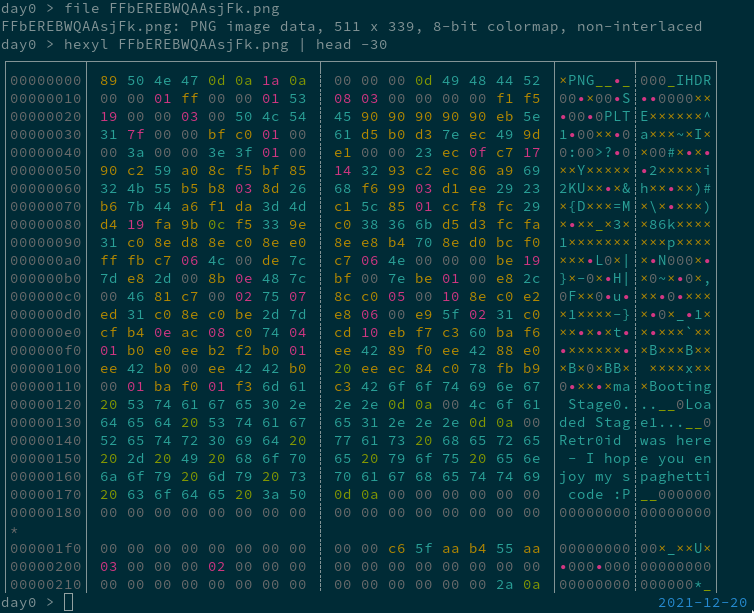
A PNG with an 8-bit colormap, hence the palette (PLTE) header. A normal PNG with an 8 bit colormap would use the next 0x300 bytes after PLTE to specify the R,B, and G values for 0x100 pixels of a custom palette.
But is “Booting Stage0… Loaded Stage1… Retr0id was here - I hope you like my spaghetti code :P” really supposed to be specifing colors? And the repeated 0x90s at the start of the PLTE header, looks a bit like a NOP sled… Wait, is that 0xaa55 at offset 0x1fe? I’ve seen that before…
According to file, my web browser, your web browser, and the twitter uploading form, this is a valid PNG file. But is that all it is? Polyglot files are files that are two filetypes at the same time, say a PDF and a ZIP file. And Retr0id has been known to make PNG polyglots before.

> file --keep-going FFbEREBWQAAsjFk.png | sed 's/\\012- /\n/g'
FFbEREBWQAAsjFk.png: PNG image data, 511 x 339, 8-bit colormap, non-interlaced
DOS/MBR boot sector
DOS/MBR boot sector
data
Yep, it’s a polyglot!
It’s not just a PNG, its a PNG that is also a bootable drive!
Initial Boot
Let’s boot it up with QEMU:
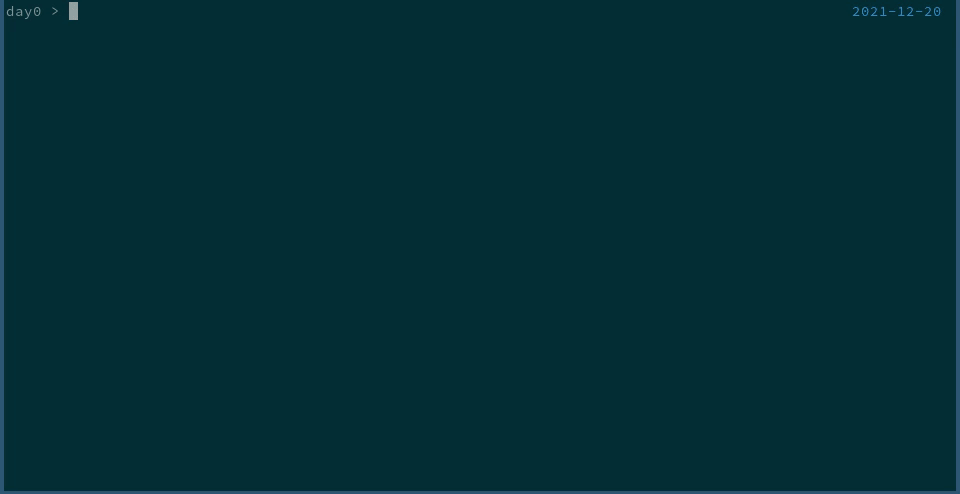
Wow that’s insane! How does it do that?
When a computer boots, the BIOS looks for a bootable drive. Drives are marked as bootable by having the magic bytes 0xaa55 at the offset 0x1fe, or 510 bytes in. If the BIOS finds one, it loads up the first sector of the drive (the boot sector) at the address 0x7c00, points the instruction pointer to the start, and just starts executing x86 instructions.
The processor starts running these instructions in Real Mode:
an operating mode that all x86 CPUs support. …
There is no memory protection, multitasking, or code privilege levels. …
for backward compatibility, all x86 CPUs start in real mode when reset
And talk about backward compatibility: Real Mode was the only mode available in the 8086 chip, released in 1979 (!) and used in the original IBM PC. Protected Mode, with virtual memory and basic privilege levels, was released with the 80286 in 1982, but you had to switch into Protected Mode. To this day, x86 CPUs still start in Real Mode.
This article from POC||GTFO is a great overview of Real Mode and how OSes boot (and the follow up is great too).
So when the PNG boots, this is what the CPU, in 16-bit “Real Mode”, sees:
> objdump -M intel -D -b binary -mi386 -Maddr16,data16 FFbEREBWQAAsjFk.png
FFbEREBWQAAsjFk.png: file format binary
Disassembly of section .data:
00000000 <.data>:
0: 89 50 4e mov WORD PTR [bx+si+0x4e],dx
3: 47 inc di
4: 0d 0a 1a or ax,0x1a0a
7: 0a 00 or al,BYTE PTR [bx+si]
9: 00 00 add BYTE PTR [bx+si],al
b: 0d 49 48 or ax,0x4849
e: 44 inc sp
f: 52 push dx
10: 00 00 add BYTE PTR [bx+si],al
12: 01 ff add di,di
14: 00 00 add BYTE PTR [bx+si],al
16: 01 53 08 add WORD PTR [bp+di+0x8],dx
19: 03 00 add ax,WORD PTR [bx+si]
1b: 00 00 add BYTE PTR [bx+si],al
1d: 00 f1 add cl,dh
1f: f5 cmc
20: 19 00 sbb WORD PTR [bx+si],ax
22: 00 03 add BYTE PTR [bp+di],al
24: 00 50 4c add BYTE PTR [bx+si+0x4c],dl
27: 54 push sp
28: 45 inc bp
29: 90 nop
2a: 90 nop
2b: 90 nop
2c: 90 nop
2d: 90 nop
2e: eb 5e jmp 0x8e
30: 31 7f 00 xor WORD PTR [bx+0x0],di
So it’s ugly, and it doesn’t do anything, but this PNG header is valid x86 code, and can be run without error by an x86 CPU on boot.

Soon after the PLTE header (50 4c 54 45), when arbitrary bytes can be written while still being a valid PNG, Santa has a NOPs sleigh and a rooftop jmp 0x8e to:
86: 33 9e c0 38 xor bx,WORD PTR [bp+0x38c0]
8a: 36 6b d5 d3 ss imul dx,bp,0xffd3
8e: fc cld
8f: fa cli
90: 31 c0 xor ax,ax
92: 8e d8 mov ds,ax
94: 8e c0 mov es,ax
96: 8e e0 mov fs,ax
98: 8e e8 mov gs,ax
9a: b4 70 mov ah,0x70
9c: 8e d0 mov ss,ax
9e: bc f0 ff mov sp,0xfff0
a1: fb sti
a2: c7 06 4c 00 de 7c mov WORD PTR ds:0x4c,0x7cde
a8: c7 06 4e 00 00 00 mov WORD PTR ds:0x4e,0x0
ae: be 19 7d mov si,0x7d19
b1: e8 2d 00 call 0xe1
b4: 8b 0e 48 7c mov cx,WORD PTR ds:0x7c48
b8: bf 00 7e mov di,0x7e00
bb: be 01 00 mov si,0x1
be: e8 2c 00 call 0xed
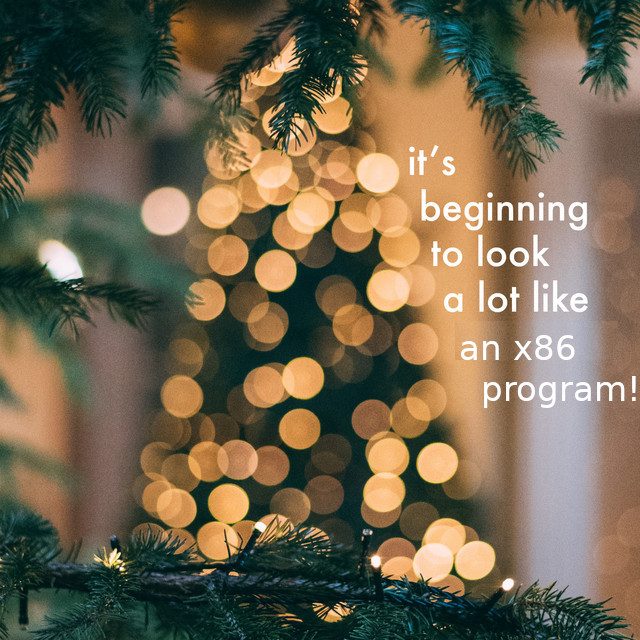
First bites of spaghetti
To debug this, you can run QEMU with the flags -S -s to stop execution at startup and run a GDB server on port 1234.
> qemu-system-i386 -S -s -drive file=FFbEREBWQAAsjFk.png
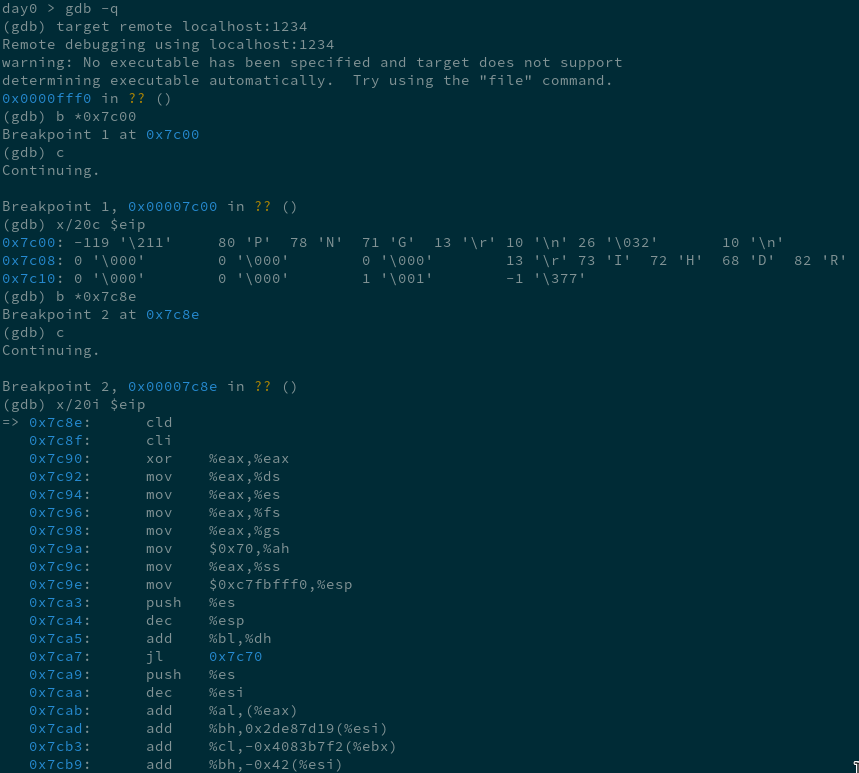
Which works, except when it doesn’t. GDB sometimes has a hard time understanding 16 bit x86 instructions, even after running set architecture i8086 (though for GDB servers in QEMU, apparently there are a couple more steps I didn’t know about). In the past I used this gdb script to better show memory layout, but it still doesn’t disassemble the code correctly.
It is pretty annoying to jump back and forth between gdb and objdump so this time I ended up using radare2, which had no problems decoding 16 bit assembly and interfaced seamlessly with the GDB server. Lets take a look at the start of the program:
> cat debug.r2
e asm.bits=16
e dbg.bpinmaps=false
db 0x7c8e
db 0x7f60
> r2 -i debug.r2 -b 16 -d gdb://localhost:1234
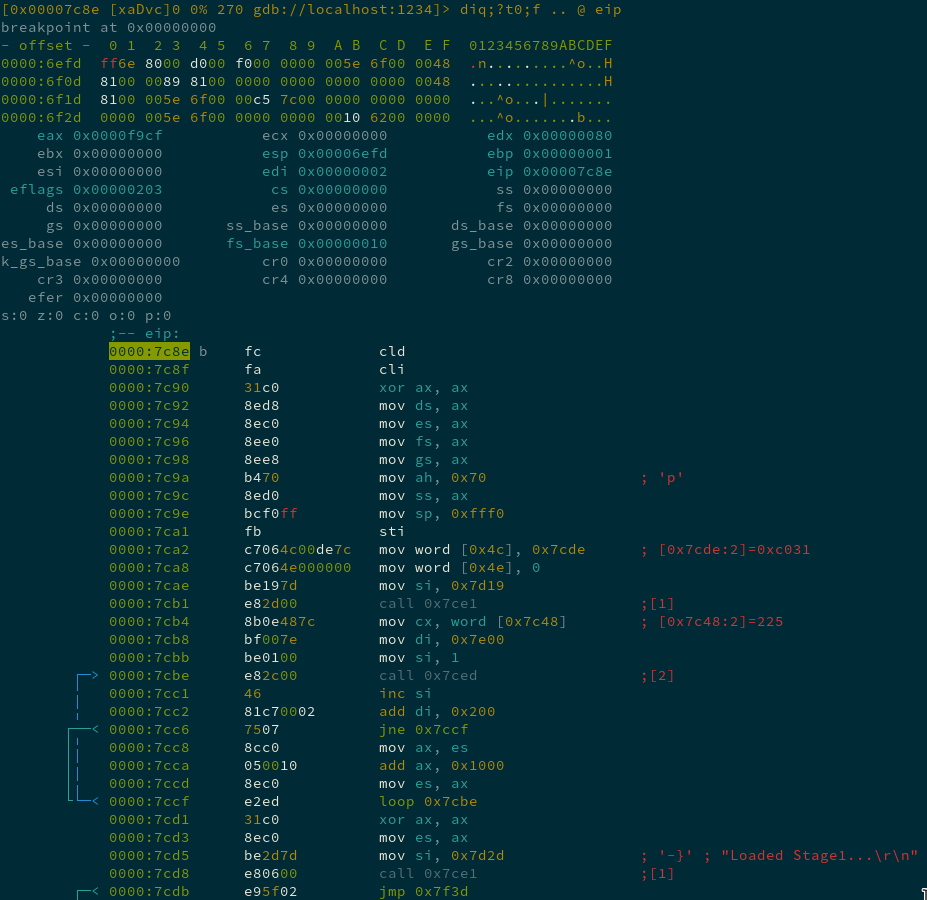
We’re still just dealing with the first 512 bytes of the PNG, the boot sector part of the file. The loop in the above code, that repeatedly calls 0x7ced, loads in the rest of the file using the IN and OUT instructions (this was an interesting read on early CPU I/O).
There are also two calls to 0x7ce1, a simple function that prints a string to the display using the int 0x10 BIOS interrupt.

At this point it was my second time running the image file, the first time in a debugger, and I had no idea what surprises the spaghett code had in store.

Getting spooked
The program then jumps to 0x7f3d, after the 0x300 bytes of PNG’s PLTE chunk, to the start of the IDAT chunk. So all the following code being run is the pixels you can actually see on the top of the original file.
At this point I realized I’d get nowhere if I keep single-stepping through the binary. So I started stepping over function calls, moving a bit quicker, and seeing what changes in the output until I found something interesting.
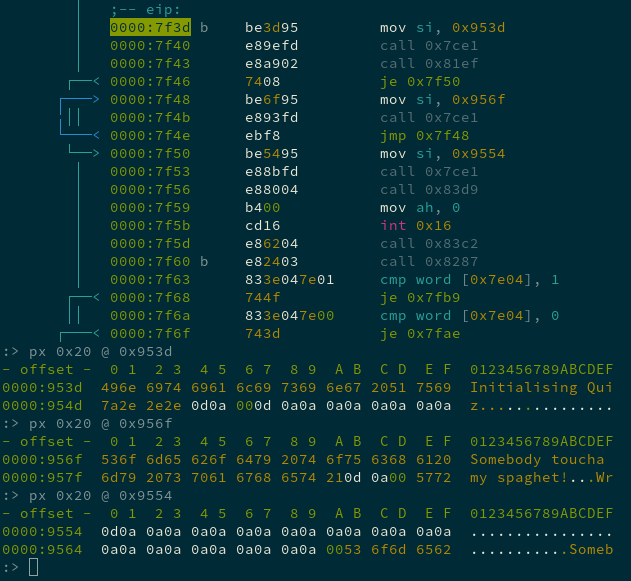
The arguments to the print function (0x7ce1) give us some overview. The program calls a function 0x81ef that initialize a quiz. If that function doesn’t return 0, it then endlessly loops, printing “Someone touched my spaghett!”.
If the call does return successfully, it prints a bunch of newline characters ("\n" or 0x0a) and calls 0x83d9, which prints the beautiful splash screen.
It then waits for user input with the keyboard interrupt int 0x16, calls what I assume are more initialization functions, and then branches depending on what value is stored in the memory location 0x7e04.
Moving even quicker, stepping over function calls, jumping all over the place, just looking for changes in the boot screen, we find that the call to 0x82db blocks, with the program now requesting input.
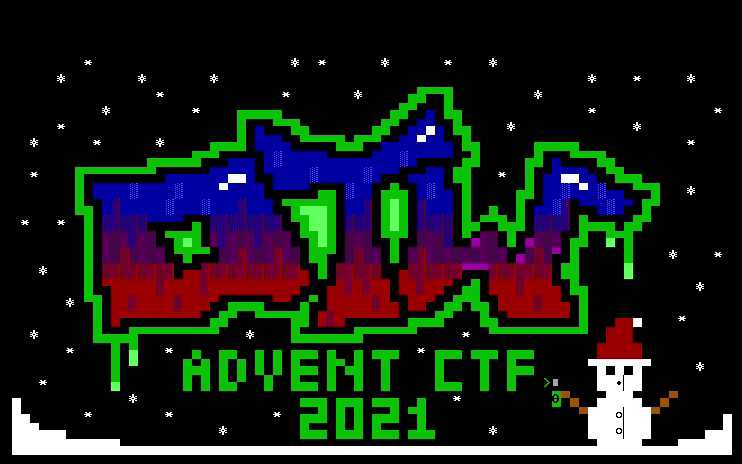
Huh. Requesting input without any prompting is class crackme behavior, which is good because we now have a goal: all we have to do is find out what the correct input is and then we’ll get the flag, right?
But wait, it wasn’t prompting for input the first time we ran it. And during subsequent debugging sessions where I was moving a bit slower, hoping to see where the input was stored and how it was checked, I was never asked for input again. What is going on?
I only realized a couple days later, when when I pulled up the bootable image to show a friend, and it was not the same one I remembered. It looked something like:

day0 > mv FFbEREBWQAAsjFk.png wrong.png
day0 > wget --quiet https://pbs.twimg.com/media/FFbEREBWQAAsjFk.png
SSL_INIT
day0 > md5sum FFbEREBWQAAsjFk.png wrong.png
3ec59e440409dabc847841c5c6e9adaf FFbEREBWQAAsjFk.png
a879b7ce54a38fb1e85e8a706329f716 wrong.png

Quiz time
So the image actually changes when we run it! Lets redownload the original and try running it a few times to see how it changes.
day0 > qemu-system-x86_64 -drive format=raw,file=FFbEREBWQAAsjFk.png
day0 > display FFbEREBWQAAsjFk.png

day0 > qemu-system-x86_64 -drive format=raw,file=FFbEREBWQAAsjFk.png
I get prompted for input, where I answer a bit indecisively, and then:
day0 > display FFbEREBWQAAsjFk.png

And again:
day0 > qemu-system-x86_64 -drive format=raw,file=FFbEREBWQAAsjFk.png
day0 > display FFbEREBWQAAsjFk.png

So now we actually know the full scope of the challenge. We have to correctly answer the 8 questions of the warmup quiz to get the flag.
But, c’mon man, do we really need to answer all 8 question? We have debugging capability, can’t we just find the answer-checking code, and no matter the input, force the checker to return true? Even better, can’t we just find the flag-printing code and run it directly?

If only it were that easy…
Checking the checker
Here are the same initialization functions as above. You can see the function call 0x81ef that (I assume) checks the integrity, and if false, will endless loop, printing “Someone touched my spaghett!” You can also see the call to 0x82db, the “Provide input” function, happens if the value at 0x7e04 is 1. And after calling it, it changes it to 2.
Looking at the broader control flow of the main function using radare2’s visual graph mode:
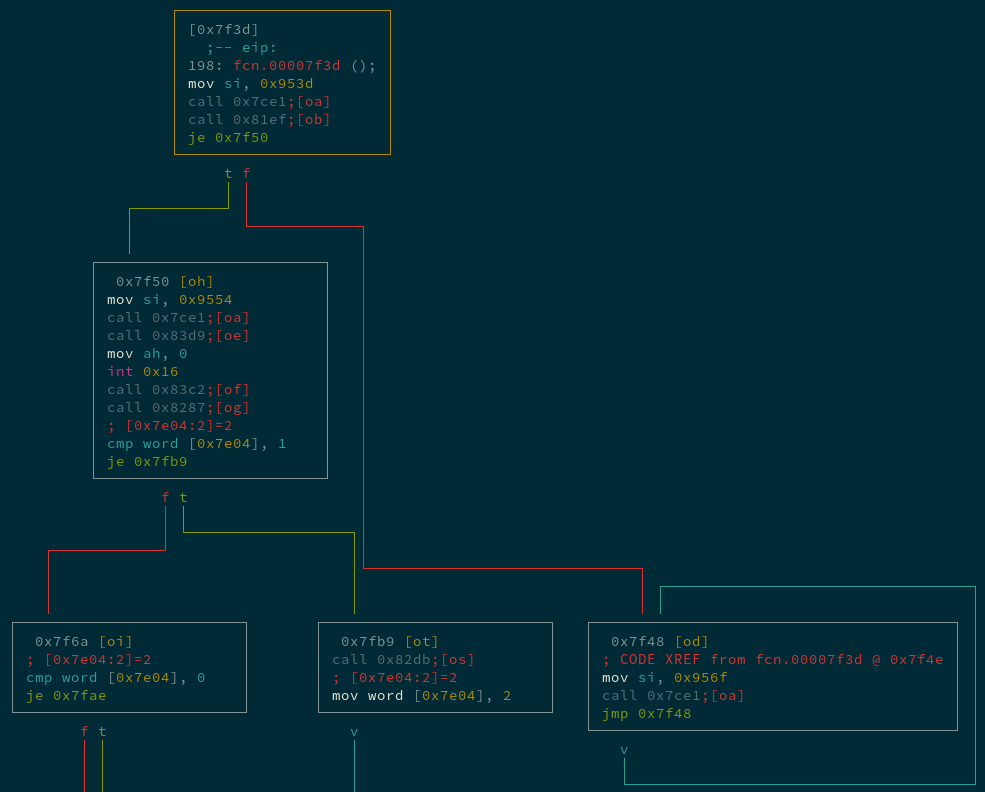
The “Initializing Quiz” (call 0x81ef) is up top, the infinite loop printing “Somone touched my spaghett!” happens if it fails, and the call to the “Provide Input” function (call 0x82db) is in the middle.
It looks like the value at 0x7e04 is important - it stores the “state” of the quiz. If 0x7e04 is set to 1 then the PNG has a quiz question displayed and on the next run the bootable code asks for the answer with “Provide input:”, setting 0x7e04 to 2.
And if this “state” value is set to 2, then the PNG has “You answered:” displayed on it. And when running the code with a state of “2”, it checks to see if the answer is correct.
So this must be that “checking” functionality:
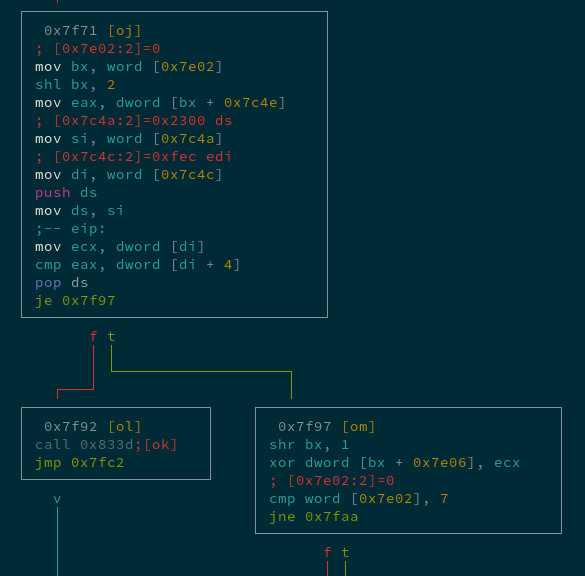
The value at 0x7e02 stores the current “question number”. So the above code grabs 4 bytes (a dword) from the array starting at 0x7c4e at the index of the question number, and stores it in eax.
This value is the “correct answer” for the current question, because it ends up cmparing it to [di+4], which (after some Real Mode memory addressing weirdness) points to the CRC at the end of the IDAT chunk just before the start of the IEND footer:
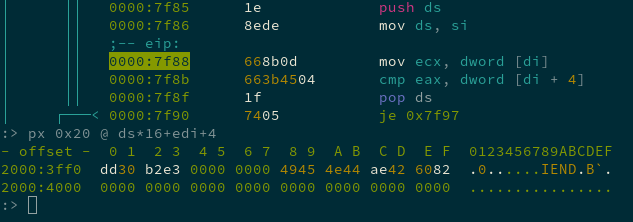
So after updating the image with the “You answered:” message and running it again, the program checks if it’s the right answer by reusing the same integrity check as the PNG specification itself, (the CRC), to compare it to a correct value.
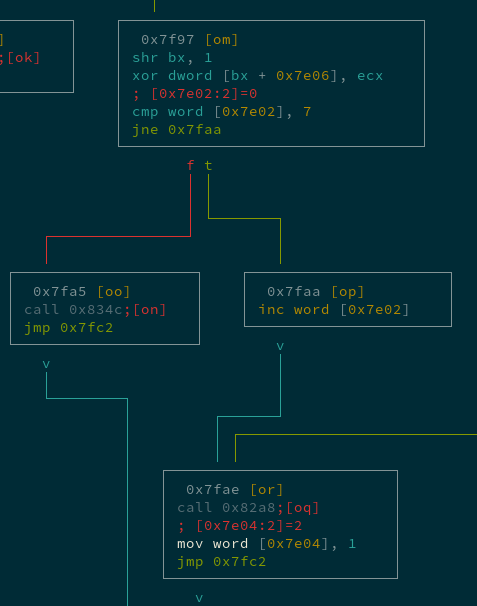
If the comparison succeeds, another value ([di]) is XORed at an array starting at 0x7e06.
If the current “question number” (0x7e02) is less than 7, it is incremented, the “state” (0x7e04) is changed to “printing a question” (1), and the program goes on to print the next question.
If the current question number is 7, then presumably our flag printing function (0x834c) is called.
Santa wants milk and cookies, not cheese!
“Okay this is cute and all, but cut the crap, lets jump to that flag printing function and see the flag”
Naturally that’s the first thing I did after identifying it, but after running it, you don’t get a valid image back - it’s mostly filled with null-bytes and some garbage. Checking the flag printing function with radare2’s ghidra decompiler (which I didn’t even know would work in real mode until doing this write-up):
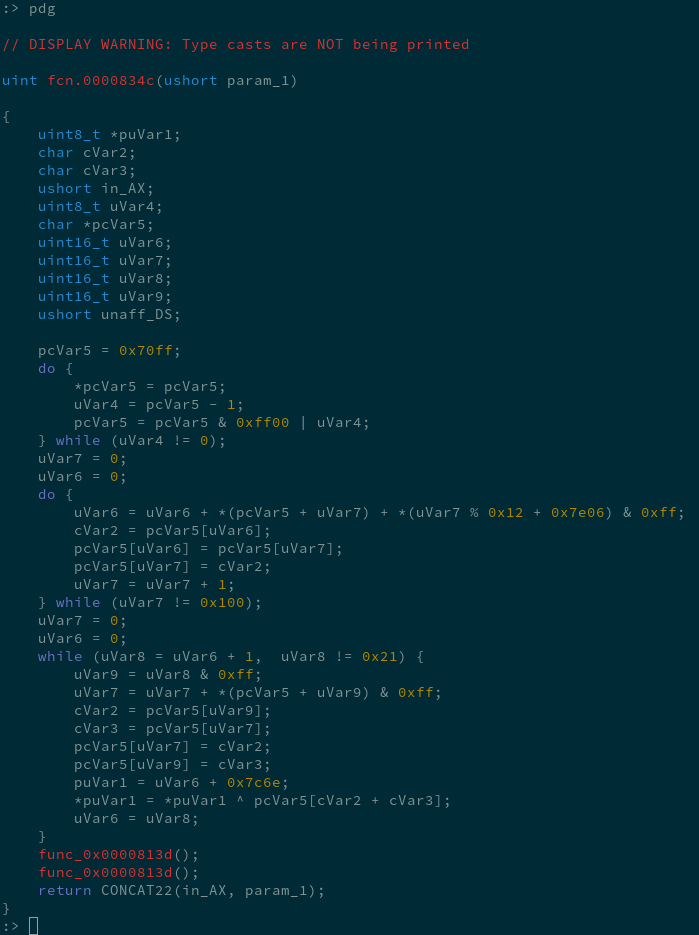
The first do...while loop here makes a 0x100 long array of bytes 0x00, 0x01, 0x02 ... 0xfe, 0xff. Searching for “0x100 bytes encryption” and it looks like the flag is encrypted with RC4, with the encrypted flag located at 0x7c6e, and the key at 0x7e06. The key is generated above, from the values at [di] across all 8 correct answers to the quiz.
To me, this was the real beauty of this challenge. At the beginning it was astonishing that a PNG file could run a program when booted as a hard disk. Near the end, it was astonishing that you actually have to answer all the questions to get the flag. (Or at least most of them, as we’ll see)
So lets answer them! (It took me an embarssingly long time to realize that it is Santa asking the questions)

Red

Rudolph

(base64 decoded to: “The answer is FROGS”)
FROGS

(ROT13 for “What is this cipher called?”)
ROT13

30258

RC4

Well, crap. I was breezing through it up until this point. But I searched google and it turns out Santa traditionally does not have a favorite 7 digit prime. We might have to brute force this one.
Brute force on Quizmas Eve
48 hours before the CTF ended with almost all of the AOTW challenges released, I took stock of flags I could try to snag before times up. I’m a n00b at pwn and that was mostly what was remaining, so I started looking at this warmup challenge again.
Around 8 hours before time, I got to this point, where I realized I needed to brute force the last few questions. It had been dark outside for a while and I was fading fast.
There are over half a million 7 digit primes. And question 8 is “What’s my password? (Hint: rockyou)”, which has tens of millions of entries.
I quickly patched together a very ugly script to brute force the 7-digit prime using the qemu monitor, sending individual keys using the sendkey command:
#!/usr/bin/env python3
import os
import sys
if len(sys.argv) != 3:
print("usage: ./brute [input.png] [list.txt]")
exit(1)
# extracted from offset 0x66 of the png
# or 0x7c4e+4*6 in the binary
target = bytes([0x8d, 0x26, 0x68, 0xf6])
with open(sys.argv[2]) as f:
list = f.readlines()
cmd = "mkdir imgs2"
print(cmd)
os.system(cmd)
for l in list:
filename = "imgs2/" + l.strip() + ".png"
cmd = "cp " + sys.argv[1] + " " + filename
os.system(cmd)
print(cmd)
cmd = "qemu-system-i386 -display none -daemonize --monitor unix:santa_socket,server,nowait -drive format=raw,file=" + filename
print(cmd)
os.system(cmd)
cmd = "./sendkeys/sendkeys \"<ret>" + l.strip() + "<ret><ret>\" | socat - unix-connect:santa_socket"
print(cmd)
os.system(cmd)
with open(filename, "rb") as f:
f.seek(0x1c3f0) # offset of final crc
crc = f.read(4)
if crc == target:
print("FOUND SANTAS FAVORITE PRIME!!!")
print(l)
exit(0)
else:
cmd = "rm " + filename
print(cmd)
os.system(cmd)
This method turned out to be very slow. About 1 guess a second. So I broke the list of primes into 10 lists and ran them all in parallel. While that was churning away, I recognized I probably couldn’t do rockyou to get Santa’s password the same way in time.
But, if I successfully brute force the answer to question 7, I should have 14 bytes of the 18 byte-long key. And cracking the remaining 2^32 bits wouldn’t exactly be fast, but would certainly be faster than running rockyou through my existing script. Here was my cracking program written in go:
package main
import (
"fmt"
"crypto/rc4"
)
func main() {
ciphertext := []byte{
0x29,0x23,0xb6,0x7b,0x44,0xa6,0xf1,0xda,
0x3d,0x4d,0xc1,0x5c,0x85,0x01,0xcc,0xf8,
0xfc,0x29,0xd4,0x19,0xfa,0x9b,0x0c,0xf5,
0x33,0x9e,0xc0,0x38,0x36,0x6b,0xd5,0xd3}
key_prefix := []byte{
0x0f,0x53,0x9a,0x42,
0x3a,0xf9,0xfe,0x19,
0x0c,0xdd,0x1f,0xcb,
// Didn't know these last two bytes until after brute forcing question 7
0x09,0x9c}
fmt.Println(key_prefix)
fmt.Println(ciphertext)
count := 0
// this is ugly i know I'm moving fast but let me tell you
// it is great practice for vim keybinds.
for i := 0; i < 256; i ++ {
for j := 0; j < 256; j ++ {
for k := 0; k < 256; k ++ {
for l := 0; l < 256; l ++ {
key := append(key_prefix, byte(i), byte(j), byte(k), byte(l))
cipher, _ := rc4.NewCipher(key)
out := make([]byte, 0x20)
cipher.XORKeyStream(out, ciphertext)
if count % 1000000 == 0 {
fmt.Println(count, "trying key:", key)
fmt.Println("with output", out)
}
count ++
if out[0] == 'A' && out[1] == 'O' && out[2] == 'T' && out[3] == 'W' && out[4] == '{' {
fmt.Println("FOUND FLAG!!!!!")
fmt.Printf("out: %s\n", out)
return
}
}
}
}
}
}
I had about 6 hours left. The 10 parallel qemu bruteforcing was running, but very slowly. A rough calculation showed I had about 1/10 chance of guessing Santa’s favorite 7 digit prime in time.
I needed a Christmas miracle. I’d been nice this year, right? Before going to sleep, I made sure to leave my browser cookies out. And I woke up early in the morning hoping Santa would leave a flag for me under the Christmas spanning tree.
Final runtime:
QEMU 6.1.0 monitor - type 'help' for more information
(qemu) sendkey ret
(qemu) sendkey 3
(qemu) sendkey 1
(qemu) sendkey 3
(qemu) sendkey 3
(qemu) sendkey 3
(qemu) sendkey 3
(qemu) sendkey 7
(qemu) sendkey ret
(qemu) sendkey ret
(qemu) FOUND SANTAS FAVORITE PRIME!!!
3133337
./brute.py q7.png xac 2540.02s user 471.96s system 5% cpu 13:57:10.44 total
And cracking the key to get the flag:
2218000000 trying key: [15 83 154 66 58 249 254 25 12 221 31 203 9 156 132 51 254 128]
with output [203 152 41 235 222 253 17 244 32 186 152 153 183 85 191 61 204 12 252 31 32 245 69 132 173 128 206 32 169 116 97 40]
FOUND FLAG!!!!!
out: AOTW{u_4r3_th3_xm45_qu1zm4st3r}
go run crack2.go 7549.51s user 188.92s system 104% cpu 2:02:51.74 total
16 hours total. Not even close.
I’m Jewish, I don’t even celebrate Christmas.
Final Notes
This was the best CTF challenge I’ve done to date. Very unique and well made, it caused me to say “holy shit” aloud many times when solving it. Thanks Retr0id!

Also I found out after the CTF ended, there is a way to run qemu by redirecting stdio to the guest using -nographic which would have sped up the final brute forcing significantly. Good to know for next time.
I didn’t even go into detail about how the program actually updates the image with the input, or how the CRC32 was recalculated, or the value of [di] used for key generation, mostly because I didn’t have time to look into it myself. But chatter in the OverTheWire Chat shows that other players used the image generation mechanisms to their advantage to brute force, which is pretty cool.
Finally, there is a cool stunt hacking / demoscene around programming bootloaders and other pieces of software in Real Mode. There are a few POC||GTFO articles with, uhhh… bootloader POCs to check out (1,2).
I also wrote my first crappy program in real mode recently, learned a lot from it and found it surprisingly fun. Programming Boot Sector Games by Oscar Toledo D. (aka nanochess) is a good intro. I was going to try to make a pentomino game bootloader or maybe a peg solitaire one but might not have the time, so if this stuff interests you and you need a side-project, you should try it out!